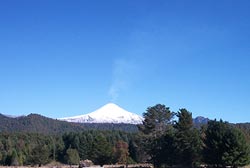Is there an ocean beneath our feet?

An arc volcano in Chile<br>
Water is carried mantle by deep sea fault zones which penetrate the oceanic plate as it bends into the subduction zone. Subduction, where an oceanic tectonic plate is forced beneath another plate, causes large earthquakes such as the recent Tohoku earthquake, as well as many earthquakes that occur hundreds of kilometers below the Earth’s surface.
Seismic modelling
Seismologists at Liverpool have estimated that over the age of the Earth, the Japan subduction zone alone could transport the equivalent of up to three and a half times the water of all the Earth’s oceans to its mantle.
Using seismic modelling techniques the researchers analysed earthquakes which occurred more than 100 km below the Earth’s surface in the Wadati-Benioff zone, a plane of Earthquakes that occur in the oceanic plate as it sinks deep into the mantle.
Analysis of the seismic waves from these earthquakes shows that they occurred on 1 – 2 km wide fault zones with low seismic velocities. Seismic waves travel slower in these fault zones than in the rest of the subducting plate because the sea water that percolated through the faults reacted with the oceanic rocks to form serpentinite – a mineral that contains water.
Some of the water carried to the mantle by these hydrated fault zones is released as the tectonic plate heats up. This water causes the mantle material to melt, causing volcanoes above the subduction zone such as those that form the Pacific ‘ring of fire’. Some water is transported deeper into the mantle, and is stored in the deep Earth.
“It has been known for a long time that subducting plates carry oceanic water to the mantle,” said Tom Garth, a PhD student in the Earthquake Seismology research group led by Professor Andreas Rietbrock.
“This water causes melting in the mantle, which leads to arc releasing some of the water back into the atmosphere. Part of the subducted water however is carried deeper into the mantle and may be stored there.
Large amounts of water deep in the Earth
“We found that fault zones that form in the deep oceanic trench offshore Northern Japan persist to depths of up to 150 km. These hydrated fault zones can carry large amounts of water, suggesting that subduction zones carry much more water from the ocean down to the mantle than has previously been suggested.
“This supports the theory that there are large amounts of water stored deep in the Earth.”
Understanding how much water is delivered to the mantle contributes to knowledge of how the mantle convects, and how it melts, which helps to understand how plate tectonics began, and how the continental crust was formed.
The research is published in Geology.
Media Contact
All latest news from the category: Earth Sciences
Earth Sciences (also referred to as Geosciences), which deals with basic issues surrounding our planet, plays a vital role in the area of energy and raw materials supply.
Earth Sciences comprises subjects such as geology, geography, geological informatics, paleontology, mineralogy, petrography, crystallography, geophysics, geodesy, glaciology, cartography, photogrammetry, meteorology and seismology, early-warning systems, earthquake research and polar research.
Newest articles

Silicon Carbide Innovation Alliance to drive industrial-scale semiconductor work
Known for its ability to withstand extreme environments and high voltages, silicon carbide (SiC) is a semiconducting material made up of silicon and carbon atoms arranged into crystals that is…

New SPECT/CT technique shows impressive biomarker identification
…offers increased access for prostate cancer patients. A novel SPECT/CT acquisition method can accurately detect radiopharmaceutical biodistribution in a convenient manner for prostate cancer patients, opening the door for more…

How 3D printers can give robots a soft touch
Soft skin coverings and touch sensors have emerged as a promising feature for robots that are both safer and more intuitive for human interaction, but they are expensive and difficult…




















